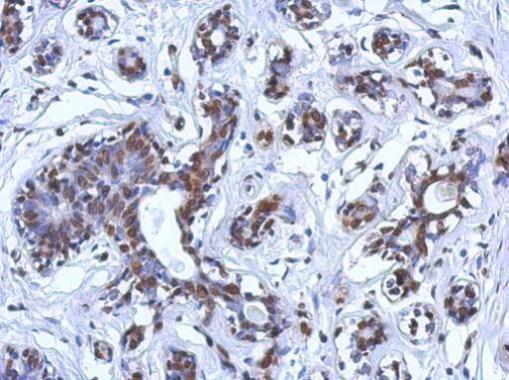Anti-BRCA1 Antibody (3302)
$503.00
SKU: 3302
Categories: Antibody Products, Cancer Research Antibodies, Products
Overview
Product Name Anti-BRCA1 Antibody (3302)
Description Anti-BRCA1 Mouse Monoclonal Antibody
Target BRCA1
Species Reactivity Human
Applications WB,IHC-P,IP,IHC
Host Mouse
Clonality Monoclonal
Clone ID 3A2
Isotype IgG1
Immunogen GST fusion protein expressed in E. coli corresponding to aa 762-1315 of full-length BRCA1.
Properties
Form Liquid
Concentration Lot Specific
Formulation PBS, pH 7.4
Buffer Formulation Phosphate Buffered Saline
Buffer pH pH 7.4
Format Purified
Purification Purified by Protein G affinity chromatography
Specificity Information
Specificity This antibody recognizes full-length BRCA1, a 220 kD nuclear phosphoprotein, and does not recognize the deltaexon 11 splice variant. In a high proportion of breast and ovarian cancer cell lines, BRCA1 aberrantly mislocates to the cytoplasm. Its usefulness to monitor functional inactivation of BRCA1 in sporadic breast cancers is under active investigation.
Target Name Breast cancer type 1 susceptibility protein
Target ID BRCA1
Uniprot ID P38398
Alternative Names EC 2.3.2.27, RING finger protein 53, RING-type E3 ubiquitin transferase BRCA1
Gene Name BRCA1
Gene ID 672
Accession Number NP_009225
Sequence Location Nucleus, Chromosome, Cytoplasm
Biological Function E3 ubiquitin-protein ligase that specifically mediates the formation of 'Lys-6'-linked polyubiquitin chains and plays a central role in DNA repair by facilitating cellular responses to DNA damage (PubMed:12890688, PubMed:14976165, PubMed:16818604, PubMed:17525340, PubMed:12887909, PubMed:10500182, PubMed:19261748). It is unclear whether it also mediates the formation of other types of polyubiquitin chains (PubMed:12890688). The BRCA1-BARD1 heterodimer coordinates a diverse range of cellular pathways such as DNA damage repair, ubiquitination and transcriptional regulation to maintain genomic stability (PubMed:12890688, PubMed:14976165, PubMed:20351172). Regulates centrosomal microtubule nucleation (PubMed:18056443). Required for appropriate cell cycle arrests after ionizing irradiation in both the S-phase and the G2 phase of the cell cycle (PubMed:10724175, PubMed:12183412, PubMed:11836499, PubMed:19261748). Required for FANCD2 targeting to sites of DNA damage (PubMed:12887909). Inhibits lipid synthesis by binding to inactive phosphorylated ACACA and preventing its dephosphorylation (PubMed:16326698). Contributes to homologous rPubMed:10500182, PubMed:10724175, PubMed:11836499, PubMed:12183412, PubMed:12887909, PubMed:12890688, PubMed:14976165, PubMed:16326698, PubMed:16818604, PubMed:17525340, PubMed:18056443, PubMed:19261748, PubMed:19369211, PubMed:20160719, PubMed:20351172}.
Research Areas Cancer Research
Application Images


Description Immunohistochemical analysis of paraffin-embedded Breast ca, using BRCA1(3302) antibody at 1:200 dilution.
Handling
Storage This antibody is stable for at least one (1) year at -70°C. Avoid multiple freeze-thaw cycles.
Dilution Instructions Dilute in PBS or medium which is identical to that used in the assay system.
Application Instructions Immunoblotting: use at 1-10 ug/mL.
Immunoprecipitation: use at 1-10 ug/mL.
Immunohistochemistry: use at 1-10 ug/mL.
Positive controls: Any normal human tissue, especially those containing rapidly proliferating cells, such as lymphoid germinal centers.
Immunoprecipitation: use at 1-10 ug/mL.
Immunohistochemistry: use at 1-10 ug/mL.
Positive controls: Any normal human tissue, especially those containing rapidly proliferating cells, such as lymphoid germinal centers.
References & Data Sheet
References Chen, Y et al. (1995) Science 270: 789- 791
Chen, C-F et al. (1995) J Biol Chem 271: 32863-32868
Chen, Y et al. (1996) Cancer Res 56: 3168-3172.
Chen, C-F et al. (1995) J Biol Chem 271: 32863-32868
Chen, Y et al. (1996) Cancer Res 56: 3168-3172.
Data Sheet  Download PDF Data Sheet
Download PDF Data Sheet
 Download PDF Data Sheet
Download PDF Data Sheet


